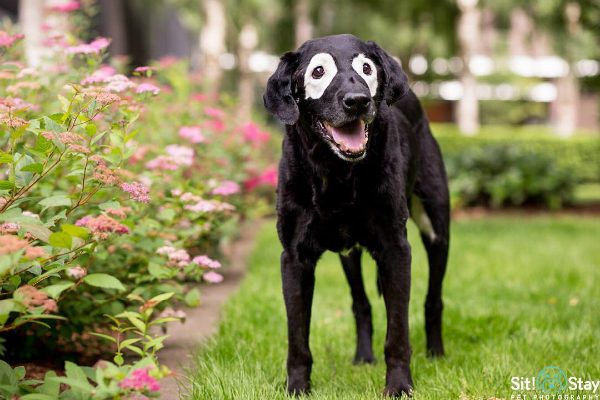
Just like humans, our canine companions are susceptible to a variety of skin disorders. Here we have listed three, including the breeds you’d most commonly find affected. In no particular order:
- Vitiligo
Vitiligo is hereditary but you wouldn’t see it when the dog is newborn or very young, it begins usually in young adulthood. Affected dogs develop bleached splotches of skin that occasionally also affects the hair coat and claws. Most splotches are on the face, especially the bridge of the muzzle or around the eyes. Color loss may come and go with varying amounts of severity. Vitiligo runs in some dog families, especially Rottweilers. Complete remission may occur but is rare. Vitiligo causes no other health problems. No treatment is available. (Treatments used in people with vitiligo are unlikely to help animals.) The thumbnail image is of Rowdy, a Black Lab with vitiligo.
- Alopecia
Dogs can be born either totally or partially without hair. Hairlessness (alopecia) can also develop later in life. It can be associated with abnormal teeth, claws, and eyes, or with skeletal and other developmental problems. Hairless breeds (Mexican Hairless, Chinese Crested, American Hairless Terrier) have been bred for these qualities. Many sporadic cases occur in other breeds of dogs, most often in males. Many affected dogs, including most of the hairless breeds, have patchy or pattern hairlessness as well as associated teeth deformities. All animals with abnormal hair development are prone to clogged hair follicles, hair follicle infections, and inflammations.
In dogs, there are several types of abnormalities in hair follicles. A syndrome known as color dilution alopecia is associated with the gene that turns normally black or liver-colored hair blue, beige, or fawn. This syndrome is best known in Doberman Pinschers but is also commonly seen in color dilute Dachshunds, Italian Greyhounds, Greyhounds, Whippets, Yorkshire Terriers, German Shepherds, silver Labrador Retrievers, and tricolor hounds. Affected dogs are born with normal hair coats but before 1 year of age begin to develop hair follicle inflammation and progressive hair loss in the blue or fawn-colored areas. Black hair follicle dysplasia develops earlier with more complete hair loss in black and white dogs. It develops shortly after birth and affects only the black-colored areas. This syndrome is most common in Papillons and Bearded Collies, and is inherited in Large Munsterlanders. Reduced hair growth in Irish Water Spaniels develops at 2 to 4 years of age.
- Ehlers–Danlos syndrome
Ehlers–Danlos syndrome is a condition in which the skin does not produce enough collagen. This causes loose, stretchy, fragile skin, and joint problems, just like people! The condition is evident from birth. Wounds heal slowly or not completely, skin hangs from the body, and cysts and bruising may develop, but it’s not fatal. Older dogs develop hanging folds of skin and develop extensive scarring, and some have joint and eye problems. Diagnosis is based on visible signs and biopsies to evaluate the collagen structure. Your vet should be able to use a skin extensibility index to diagnose the syndrome. There have been some reports of improvement for affected dogs following vitamin C supplements, and your veterinarian will be able to determine whether such supplements might help your pet!
Thank you to:
Merck Veterinary Manual
Dogster, for the picture of Rowdy

